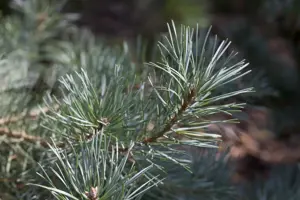Syringa vulgaris 'Mme Lemoine' - 30-40 CM C2
Syringa vulgaris 'Mme Lemoine' - 30-40 CM C2
Description
The Common lilac 'Mme Lemoine' (Syringa vulgaris) is an upright, dense, loose, branched large shrub that produces white flowers arranged in panicles with a strong fragrance. They appear from the beginning of May to the end of May. The Common lilac 'Mme Lemoine' also has heart-shaped, dark green leaves. In a sunny to semi-shady location with humus-rich, nutrient-rich, sandy, loamy soil, it usually reaches a height of around 5 metres and grows to a width of around 5 metres.
Synonym
Synonyms (botanical): Syringa vulgaris 'Madame Lemoine'.
Bulletpoints
* Suitable for flowering hedges
* the flowers are highly favoured by bees, bumblebees and hoverflies
* cut flower
* strongly scented flowers
* attractive yellow autumn colouring
* tolerates pruning
* easy to care for
* heat tolerant, resistant to urban climates, wind resistant, smoke hardy, heat loving, deer resistant
leaves
The deciduous leaves of the Common lilac 'Mme Lemoine's are dark green, heart-shaped, opposite. They are about 5 - 12 cm in size. Common lilac 'Mme Lemoine' turns bright yellow in autumn.
Bark
Striped, torn bark.
Spread
Southern Europe.
Frost hardiness
The Common lilac 'Mme Lemoine' has good frost hardiness.
Growth
Common lilac 'Mme Lemoine' is an upright, dense, loose and branching large shrub. It usually reaches a height of 3 - 5 m and is approx. 3 - 5 m wide. It usually grows 20 - 50 cm per year.
Water
The plant has a medium water requirement.
Pruning
Pruning, ideally from June to July, is advisable for this plant.
Location
Preferred location in a sunny to semi-shady position.
Soil
Normal soil.
Planting time
Container plants can be planted all year round, except when the soil is frozen and in summer heat (over 30°C).
Planting partner
The Common lilac 'Mme Lemoine' sets beautiful accents together with:
Common privet, large-leaved barberry, firethorn.
Tasks
- Fertilise: In the period from March to April
- Watering: In the period from May to September
- Pruning: In the period from June to July.
Care
- A slow-release fertiliser can be used in spring. This releases the nutrients slowly and continuously so that the plant is evenly supplied over a longer period of time.
- Lilacs flower on biennial wood, so the plant should be thinned out after flowering or plants that have grown too large should be pruned.
Flower
The white, double flowers of the Common lilac 'Mme Lemoine' appear in panicles from the beginning of May to the end of May. These are strongly scented.
Use
Pruning, solitary, park, bee pasture, hedge, scented garden
Root
Syringa vulgaris 'Mme Lemoine' is a taproot and, depending on the soil, forms runner-forming, strongly spreading roots.
- Article number1500
-
EAN codeSYVLEMOI-2030040C2
- Latin nameSyringa vulgaris 'Mme Lemoine'
- catalogLandscape shop



